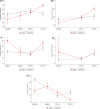Fluoridation cessation and children's dental caries: A 7-year follow-up evaluation of Grade 2 schoolchildren in Calgary and Edmonton, Canada
- PMID: 34309045
- PMCID: PMC9542152
- DOI: 10.1111/cdoe.12685
Fluoridation cessation and children's dental caries: A 7-year follow-up evaluation of Grade 2 schoolchildren in Calgary and Edmonton, Canada
Abstract
Objectives: We examined the effect of fluoridation cessation on children's dental caries experience in the Canadian cities of Calgary (cessation in 2011) and Edmonton (still fluoridated).
Methods: We used a pre-post cross-sectional design with comparison group. We studied Grade 2 schoolchildren (approximately 7 years old) 7-8 years after fluoridation cessation in Calgary, thus capturing children born after cessation occurred. Data collection included a dental examination conducted in school by calibrated dental hygienists, a questionnaire completed by parents, and fingernail clippings for a small subsample. Our overall analytic approach was twofold. We first examined differences in dental caries experience (deft and DMFT, and smooth surface caries based on defs and DMFS) between Calgary and Edmonton and over time (comparing 2018/2019 data to pre-cessation and early post-cessation surveys in our setting). Second, we evaluated whether differences were likely to reflect fluoridation cessation in Calgary, rather than other factors.
Results: The prevalence of caries in the primary dentition was significantly higher (P < .05) in Calgary (fluoridation cessation) than in Edmonton (still fluoridated). For example, crude deft prevalence in 2018/2019 was 64.8% (95% CI 62.3-67.3), n = 2649 in Calgary and 55.1% (95% CI 52.3-57.8), n = 2600 in Edmonton. These differences were consistent and robust: they persisted with adjustment for potential confounders and in the subset of respondents who were lifelong residents and reported usually drinking tap water; they had widened over time since cessation; and they were corroborated by assessments of dental fluorosis and estimates of total fluoride intake from fingernail clippings. Findings for permanent teeth were less consistent, which likely reflects that 7-year-olds have not had the time to accumulate enough permanent dentition caries experience for differences to have become apparent.
Conclusions: Our findings are consistent with an adverse impact of fluoridation cessation on children's dental health in Calgary and point to the need for universal, publicly funded prevention activities-including but not limited to fluoridation.
Keywords: caries; dental health; fluoridation; prevention; public health policy.
© 2021 The Authors. Community Dentistry and Oral Epidemiology published by John Wiley & Sons Ltd.
Conflict of interest statement
There are no conflicts of interest to declare.
Figures


Similar articles
-
Exploring the short-term impact of community water fluoridation cessation on children's dental caries: a natural experiment in Alberta, Canada.Public Health. 2017 May;146:56-64. doi: 10.1016/j.puhe.2016.12.040. Epub 2017 Feb 7. Public Health. 2017. PMID: 28404475
-
Fluoridation cessation and oral health equity: a 7-year post-cessation study of Grade 2 schoolchildren in Alberta, Canada.Can J Public Health. 2022 Dec;113(6):955-968. doi: 10.17269/s41997-022-00654-4. Epub 2022 Jul 7. Can J Public Health. 2022. PMID: 35799095 Free PMC article.
-
Measuring the short-term impact of fluoridation cessation on dental caries in Grade 2 children using tooth surface indices.Community Dent Oral Epidemiol. 2016 Jun;44(3):274-82. doi: 10.1111/cdoe.12215. Epub 2016 Feb 17. Community Dent Oral Epidemiol. 2016. PMID: 26888380 Free PMC article.
-
Efficacy of preventive agents for dental caries. Systemic fluorides: water fluoridation.Caries Res. 1993;27 Suppl 1:2-8. doi: 10.1159/000261594. Caries Res. 1993. PMID: 8500120 Review.
-
Dental caries in children in Ireland: A systematic review.Community Dent Oral Epidemiol. 2024 Feb;52(1):24-38. doi: 10.1111/cdoe.12897. Epub 2023 Jul 29. Community Dent Oral Epidemiol. 2024. PMID: 37515429
Cited by
-
Analysis of Fluoride-Free Content on Twitter: Topic Modeling Study.J Med Internet Res. 2023 Jun 20;25:e44586. doi: 10.2196/44586. J Med Internet Res. 2023. PMID: 37338975 Free PMC article.
-
Where public health meets public opinion: Understanding political support for fluoridation in Calgary, 2021.Can J Public Health. 2025 Apr;116(2):309-315. doi: 10.17269/s41997-024-00960-z. Epub 2024 Nov 18. Can J Public Health. 2025. PMID: 39557770
-
Facts and Fallacies of the Fluoride Controversy: A Contemporary Perspective.Int Dent J. 2025 Aug;75(4):100833. doi: 10.1016/j.identj.2025.04.013. Epub 2025 May 12. Int Dent J. 2025. PMID: 40359684 Free PMC article. Review.
-
Family physicians as advocates for community water fluoridation.Can Fam Physician. 2023 May;69(5):314-318. doi: 10.46747/cfp.6905314. Can Fam Physician. 2023. PMID: 37173001 Free PMC article. No abstract available.
-
Associations between school-based fluoride mouth-rinse program, medical-dental expense subsidy policy, and children's oral health in Japan: an ecological study.BMC Public Health. 2024 Mar 12;24(1):762. doi: 10.1186/s12889-024-18156-y. BMC Public Health. 2024. PMID: 38475804 Free PMC article.
References
-
- Burt BA, Eklund SA Dentistry, Dental Practice, and the Community, 5th edn. Philadelphia, PA: W.B. Saunders; 1999.
-
- Rose G. Sick individuals and sick populations. Int J Epidemiol. 2001;30(3):427‐432. - PubMed
-
- Brown HK, McLaren HR, Josie GH, Stewart BJ. The Brantford‐Sarnia‐Stratford fluoridation caries study 1955 report. Can J Public Health. 1956;47:149‐159. - PubMed
Publication types
MeSH terms
Substances
Grants and funding
LinkOut - more resources
Full Text Sources
Medical
Miscellaneous

